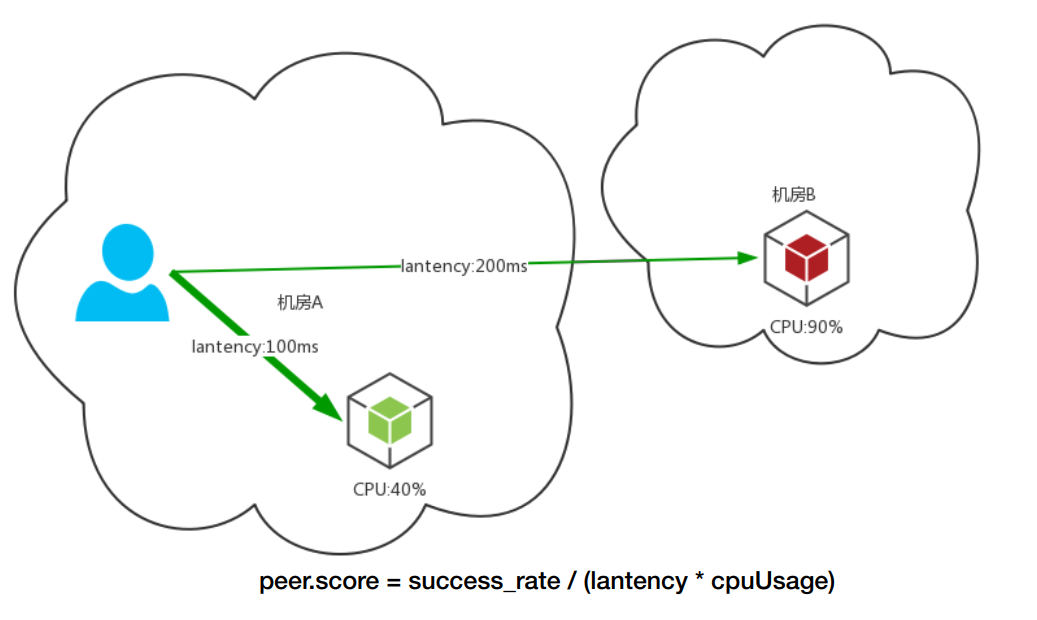0x00 前言
回顾下在先前的文章 gRPC 源码分析之官方 Picker 实现 中,分析过实现自定义 gRPC Balancer 算法的三个步骤:
- 注册
Balancer的名字 - 实现
PickerBuild及Builder()方法,用于当 resolver 解析器发生解析变更时(后端节点增删)时,更新Picker使用的 LoadBalance-Pool - 实现
Picker及Picker()方法,用于客户端每次 RPC 调用时,进行 LoadBalance 算法的 Choice
0x01 Kratos 的 WRR 算法
Kratos 在传统的 Nginx-WRR 算法 的基础上,为加权轮询算法增加了 动态调节权重值 ,用户可以在为每一个 Backend 先配置一个初始的权重分,之后算法会根据 Backend 节点 CPU、延迟、服务端错误率、客户端错误率动态打分,(每一次 RPC 调用后)在将打分乘用户自定义的初始权重分得到最后的权重值。
0x02 WRR 的实现
结构
定义 Backend 服务的结构:
type serverInfo struct {
cpu int64
success uint64 // float64 bits
}
封装的 balancer.Subconn 结构,加入了对此连接的属性
type subConn struct {
conn balancer.SubConn // 一个 conn 代表到一个 backend 的长连接
addr resolver.Address
meta wmeta.MD
err metric.RollingCounter
latency metric.RollingGauge
si serverInfo
// effective weight
ewt int64
// current weight
cwt int64
// last score
score float64
}
LB 算法
自定义 LB 实现的组件,wrrPickerBuilder 以及 wrrPickerBuilder.Build() 方法,wrrPicker 以及 wrrPicker.Pick() 方法:
type wrrPickerBuilder struct{}
type wrrPicker struct {
// subConns is the snapshot of the weighted-roundrobin balancer when this picker was
// created. The slice is immutable. Each Get() will do a round robin
// selection from it and return the selected SubConn.
subConns []*subConn // 使用自定义的 subConn,里面封装了 gRPC 库的 balancer.SubConn,方便加入更多属性
//subConns 标识所有活动连接数组
colors map[string]*wrrPicker // 保存 color 的 picker 逻辑(颜色筛选)
updateAt int64
mu sync.Mutex
}
再看下 wrrPickerBuilder.Build(),该方法由参数的 readySCs,根据权重,构造出给 wrrPicker 选择的初始化连接集合:
这里有一个细节需要注意,在 gRPC 中,当 Resolver 中的监听器 监控到后端节点发生了改变(下线或上线) 时,才会触发下面 Build() 的调用:
func (*wrrPickerBuilder) Build(readySCs map[resolver.Address]balancer.SubConn) balancer.Picker {
//readySCs 是从 gRPC 的 conn-pool 拿到的最新的可用连接池(每次 watcher 触发都会调用,如果 readyScs 后端无改动,则不会)
// 初始化需要返回的结构(balancer.Picker)
//map[{127.0.0.1:11111 <nil> 0 0xc00000fed0}:0xc0001cf270 {127.0.0.1:11112 <nil> 0 0xc00021e2f0}:0xc000214a90]
p := &wrrPicker{
colors: make(map[string]*wrrPicker),
}
for addr, sc := range readySCs {
meta, ok := addr.Metadata.(wmeta.MD)
if !ok {
// 如果未定义权重,初始化权重为 10
meta = wmeta.MD{
Weight: 10,
}
}
subc := &subConn{
conn: sc, //save
addr: addr, //save
meta: meta,//save
ewt: int64(meta.Weight),
score: -1,
err: metric.NewRollingCounter(metric.RollingCounterOpts{
Size: 10,
BucketDuration: time.Millisecond * 100,
}),
latency: metric.NewRollingGauge(metric.RollingGaugeOpts{
Size: 10,
BucketDuration: time.Millisecond * 100,
}),
// 初始化 cpu 和成功率的值
si: serverInfo{cpu: 500, success: math.Float64bits(1)},
}
if meta.Color == "" {
p.subConns = append(p.subConns, subc)
continue
}
// if color not empty, use color picker
// 构建 color 选择
cp, ok := p.colors[meta.Color]
if !ok {
cp = &wrrPicker{}
p.colors[meta.Color] = cp
}
cp.subConns = append(cp.subConns, subc)
}
return p
}
节点权重的计算公式
先看下在代码中,权重的更新值是如何计算的。核心代码 在此: $peer.Score=\frac{succrate}{latency*cpuUsage}$

......
for i, conn := range p.subConns {
cpu := float64(atomic.LoadInt64(&conn.si.cpu))
ss := math.Float64frombits(atomic.LoadUint64(&conn.si.success))
// 从滑动窗口中获取错误总数和请求总数
errc, req := conn.errSummary()
// 从滑动窗口计算平均 req 延迟
lagv, lagc := conn.latencySummary()
if req > 0 && lagc > 0 && lagv > 0 {
// client-side success ratio
cs := 1 - (float64(errc) / float64(req))
// 成功率校正
if cs <= 0 {
cs = 0.1
} else if cs <= 0.2 && req <= 5 {
cs = 0.2
}
// 根据下式得到 conn(也就是 node)的打分,1e9=10^9
conn.score = math.Sqrt((cs * ss * ss * 1e9) / (lagv * cpu))
stats[i] = statistics{cs: cs, ss: ss, lantency: lagv, cpu: cpu, req: req}
}
stats[i].addr = conn.addr.Addr
if conn.score > 0 {
total += conn.score
count++
}
}
......
Picker 实现
真正实现 WRR 的算法在下面这个方法中:
func (p *wrrPicker) Pick(ctx context.Context, opts balancer.PickOptions) (balancer.SubConn, func(balancer.DoneInfo), error) {
// FIXME refactor to unify the color logic,每次客户端 RPC-CALL 都会调用
color := nmd.String(ctx, nmd.Color)
if color == ""&& env.Color !="" {
color = env.Color
}
if color != "" {
if cp, ok := p.colors[color]; ok {
// 如果定义了 color,走 color 的筛选逻辑
return cp.pick(ctx, opts)
}
}
// 走默认的 picker 逻辑
return p.pick(ctx, opts)
}
func (p *wrrPicker) pick(ctx context.Context, opts balancer.PickOptions) (balancer.SubConn, func(balancer.DoneInfo), error) {
var (
conn *subConn
totalWeight int64
)
if len(p.subConns) <= 0 {
return nil, nil, balancer.ErrNoSubConnAvailable
}
// 下面是 nginx 的 Weight-rr 算法实现
p.mu.Lock()
for _, sc := range p.subConns {
totalWeight += sc.ewt
sc.cwt += sc.ewt
if conn == nil || conn.cwt < sc.cwt {
conn = sc
}
}
// 按照 WRR 算法的要求
conn.cwt -= totalWeight
p.mu.Unlock()
// 计算本次 RPC 请求的延迟
start := time.Now()
if cmd, ok := nmd.FromContext(ctx); ok {
cmd["conn"] = conn
}
return conn.conn, func(di balancer.DoneInfo) {
// 请求失败计数
ev := int64(0) // error value ,if error set 1
if di.Err != nil {
if st, ok := status.FromError(di.Err); ok {
// only counter the local grpc error, ignore any business error
if st.Code() != codes.Unknown && st.Code() != codes.OK {
ev = 1
}
}
}
// 失败计数 + 1,成功不加
conn.err.Add(ev)
// 计算本次 RPC 请求的延迟
now := time.Now()
conn.latency.Add(now.Sub(start).Nanoseconds() / 1e5)
u := atomic.LoadInt64(&p.updateAt)
if now.UnixNano()-u < int64(time.Second) {
return
}
if !atomic.CompareAndSwapInt64(&p.updateAt, u, now.UnixNano()) {
return
}
var (
stats = make([]statistics, len(p.subConns))
count int
total float64
)
for i, conn := range p.subConns {
//p.subConns 里面保存了当前连接池中所有和 backend 的连接及其属下(权重)
cpu := float64(atomic.LoadInt64(&conn.si.cpu))
ss := math.Float64frombits(atomic.LoadUint64(&conn.si.success))
errc, req := conn.errSummary()
lagv, lagc := conn.latencySummary()
if req > 0 && lagc > 0 && lagv > 0 {
// client-side success ratio
cs := 1 - (float64(errc) / float64(req))
if cs <= 0 {
cs = 0.1
} else if cs <= 0.2 && req <= 5 {
cs = 0.2
}
conn.score = math.Sqrt((cs * ss * ss * 1e9) / (lagv * cpu))
stats[i] = statistics{cs: cs, ss: ss, lantency: lagv, cpu: cpu, req: req}
}
stats[i].addr = conn.addr.Addr
if conn.score > 0 {
total += conn.score
count++
}
}
// count must be greater than 1,otherwise will lead ewt to 0
if count < 2 {
return
}
avgscore := total / float64(count)
p.mu.Lock()
for i, conn := range p.subConns {
if conn.score <= 0 {
// 更新节点得分
conn.score = avgscore
}
conn.ewt = int64(conn.score * float64(conn.meta.Weight))
stats[i].ewt = conn.ewt
}
p.mu.Unlock()
log.Info("warden wrr(%s): %+v", conn.addr.ServerName, stats)
}, nil
}
0x03 总结
通过阅读 Kratos 这部分代码,有如下收获:
- 错误率和延迟的计算,采用滑动窗口得到更平滑(精确)的取值
- 对
balancer.SubConn的封装,将 WRR 算法需要的权重数据完美的封装在自定义的结构中 - 通过 gRPC 的
Tailer()机制返回节点的 CPU 利用率,动态更新 WRR 算法中定义的节点权重值
0x04 参考
转载请注明出处,本文采用 CC4.0 协议授权